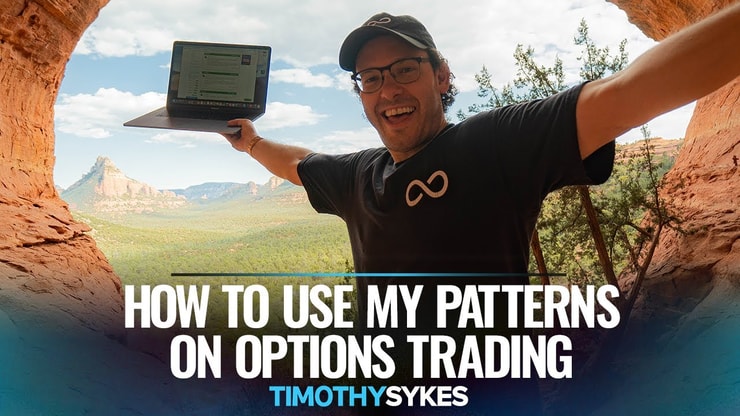Options trading works as a complement to straight stock trading — but it can get way more complicated. Options trading is a major trading niche, so even if you don’t partake, it’s still a good idea to understand it.
Personally, I don’t trade options. But my former student and Trading Challenge mentor Mark Croock does — and he’s really good at it. He made most of his $3.9 million in career gains from options trading.
Options trading and stock trading are two wildly different animals. Read on to learn more about the basic concepts of options trading!
Table of Contents
What Are Options?

Options are financial instruments based on underlying securities. This means an option doesn’t have value in itself — it only gives you the right to buy or sell its underlying asset at an agreed-upon price within a certain time frame.
The options market has two parties: the holder/option trader and writer/option seller. As an option holder, you pay the writer for the right to trade an asset for a certain price during a specified timeframe.
Check this guide to learn more about what options trading is!
How Options Pricing Works
Options prices are called ‘premiums.’ Two factors determine them:
- Intrinsic value: The difference between the current stock price and the strike price (the point at which you can execute an options trade)
- Time value: The time remaining until the contract expires
An options contract only has intrinsic value if it’s ‘in the money’ (ITM). Being in the money means the strike price is within the executable range.
You’re in the money on call options if the strike price is under the underlying asset’s current price. On put options, you’re in the money if the strike price is above current market prices.
‘Out of the money’ (OTM) options are cheaper to buy, but they may never reach ITM status.
An options contract’s time value is the largest if there’s a lot of time before it expires. Contracts with longer expiration periods are more valuable — there’s more time for them to be in the money.
They also cost more to buy.
An options contract can experience time decay. This happens because it loses value as it nears the expiration date.
What Are Options Contracts?
Options contracts represent the right to buy or sell a certain asset. They can be taken out for all kinds of securities and assets.
Most options contracts give you the right to buy 100 shares of stock or other assets. You can buy options for stocks, mutual funds, exchange-traded funds, and other financial products.
Like the stock market, you get access to options trading through online brokerages. You might need approval from the brokerage firm before buying and selling options.
The money you pay for a stock option contract is called a ‘premium.’ You’ll only lose the premium if you let the options contract expire without exercising it. American-style options can be executed when they reach or pass their ‘strike price.’
You’ll encounter American and European options depending on the asset traded. The main difference between these two options styles is their flexibility.
You can exercise American-style options anytime before and on their expiration date. You can only exercise European options on their exact expiration date.
Both these types of options contracts are available on assets traded in the U.S., and you won’t get a choice of which option style you’ll get. Stocks and ETFs usually use American-style options. Meanwhile, the majority of options on commodity and index markets use European-style contracts.
Types of Options: Calls and Puts

There are two basic types of options contracts: calls and puts.
Call Options
A call option gives you the right to buy the underlying asset at the agreed-upon strike price for a certain period of time.
It’s best to buy a call option if you expect a price increase. Why? This way, you can lock in a lower strike price and sell the asset or options contract for a profit.
Call Option Example
Suppose stock in Company X has a current price of $40 per share. You think it will trend up at least 20% within the next few months, so you buy a call option to purchase 100 shares at a strike price of $48 each.
If you’re right and the share price rises above $48 before your call expires, you can execute the option and make money from the difference.
But if the reverse happens and the price falls under $48, you can ignore the options contract. All you’ll lose is the option premium.
Put Options
A put option is the opposite of a call option. It gives you the right to sell a stock at the agreed-upon strike price for a certain time period.
Put options are a little more complicated than call options. This is because you have to own the underlying security to execute the contract.
What happens if you don’t have the underlying asset? You can just sell the put contract because the time value has some monetary worth.
Put Option Example
Suppose you predict Company X’s stock price will trend down in a few months. In anticipation, you buy a call option to sell 100 shares of Company X stock at $36 per share two months from now.
This gives you a price floor and lets you sell shares at $36 each if the price falls past that strike price. Afterward, you can buy them back at the lower current price.
So, what happens if the price goes up instead? You can just ignore the contract and only lose the premium. This is an options strategy called ‘hedging.’
Read this guide to learn more about how to trade options!
Use Cases of Call and Put Options

When should you trade calls, and when should you trade puts? Here’s a simple breakdown:
- You buy calls when you expect a stock to rise in price. When the stock price rises above the strike price, you can execute the call at the strike price and profit from the difference.
- You buy puts when you expect a stock to fall in price. Puts are the inverse of calls. You buy them when you see a downtrend in the stock, and want to lock in a higher price.
- You can also sell calls and puts before expiration. There are various reasons that traders sell options — to recoup a premium, because they don’t agree on the underlying asset’s prospects with the option buyer, or to pull off complicated options strategies like the iron condor.
It only gets more complex from there! When you’re building your options strategy, investing in your knowledge account should be the first step.





Leave a reply